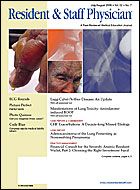Publication
Article
Resident & Staff Physician®
Commentary
Author(s):
Bobby S. Korn, MD, PhD
Clinical Instructor
Don O. Kikkawa, MD
Professor of Clinical Ophthalmology
Division of Ophthalmic Plastic and Reconstructive Surgery
Department of Ophthalmology
University of California, San Diego
Shiley Eye Center
San Diego, Calif
We applaud the author's excellent review of the diagnosis and management of orbital fractures and would like to add our own experience. As ophthalmologists, our primary concern is the preservation of vision. Thus, we believe that any case of suspected orbital or ocular trauma warrants consultation with an ophthalmologist, regardless of whether ocular signs or symptoms are present.
The most important condition to rule out is a ruptured globe. The patient should not be allowed to take anything by mouth. A protective eye shield that rests on the bony orbital rim should be placed and adequate pain and nausea control instituted. Pain control is essential to prevent extrusion of the ocular contents from excessive Valsalva pressure. All manipulations of the globe should be avoided until the globe has been deemed intact by ophthalmic examination.1
As described in this case, retrobulbar hemorrhage is an ocular emergency that requires immediate attention. Prompt diagnosis and treatment is essential to prevent blindness. An expanding retrobulbar hemorrhage can cause an orbital compartment syndrome, leading to ischemia of the optic nerve. Once this happens, permanent and irreversible blindness can occur in as little as 90 minutes, based on primate studies.2 Keys to the diagnosis of an orbital hemorrhage include proptosis, decreased vision, increased intraocular pressure, and the presence of a relative afferent papillary defect. Management includes performing a lateral canthotomy of the overlying skin and muscle and, more importantly, lysis of the lateral canthal tendon (cantholysis). Only after the tendon is lysed can the orbital contents prolapse forward, relieving the compartment syndrome. If lateral canthotomy fails to alleviate the compartment syndrome, orbital decompression should be performed in an emergent operative setting.3
Pediatric cases of orbital trauma require special considerations. The anatomy of the orbit and adnexal tissues undergo dramatic changes as we age. The frontal sinus is the last of the paranasal sinuses to pneumatize and is not visible radiographically until the sixth year of life. As a result, frontal trauma can lead to orbital roof fractures in young children. In adults, the fully developed frontal sinus acts as a crumple zone that absorbs trauma. The presence of pulsatile proptosis, cerebrospinal fluid rhinorrhea, signs of meningeal irritation, or pneumocephalus on brain imaging should alert the clinician to the possibility of orbital roof fractures. Immediate neurosurgical consultation is warranted in such cases.4
Orbital floor fractures are also different in children. In adults, the rigid nature of the orbital floor causes most fractures to remain displaced. In children, the orbital floor is more pliable, causing a higher rate of inferior rectus muscle entrapment because of a "trapdoor" effect. Prolonged entrapment can cause ischemic necrosis of the muscle or permanent scarring, leading to impaired ocular motility. In visually immature children, this induced diplopia can result in vision loss secondary to amblyopia. Sometimes, life-threatening bradycardia can result from excessive stimulation of the oculocardiac reflex as a result of an impinged extraocular muscle.5 Urgent surgical repair is mandatory.
Trauma to the orbit and adnexal tissues requires timely diagnosis and evaluation. Knowledge of the vision- threatening complications of orbital trauma and prompt ophthalmic evaluation will ensure optimal patient outcomes.
Surgical Anatomy of the Ocular Adnexa:
A Clinical Approach. Ophthalmology Monograph 9
1. Jordan DR, Anderson RA. . San Francisco, Calif: American Academy of Ophthalmology; 1996.
Ophthalmology
2. Hayreh SS, Kolder HE, Weingeist TA. Central retinal artery occlusion and retinal tolerance time. . 1980;87:75-78.
Surgery of the Eyelid, Orbit, and Lacrimal
System
3. Dortzbach RK, Kikkawa DO. Blowout fractures of the orbital floor. In: Stewart WB, ed. . American Academy of Ophthalmology; 1995:204-205.
Ophthalmology
4. Greenwald MJ, Boston D, Pensler JM, et al. Orbital roof fractures in childhood. . 1989;96:491-496.
Ophthalmology
5. Egbert JE, May K, Kersten RC, Kulwin DR. Pediatric orbital floor fracture: direct extraocular muscle involvement. . 2000;107:1875-1879.
